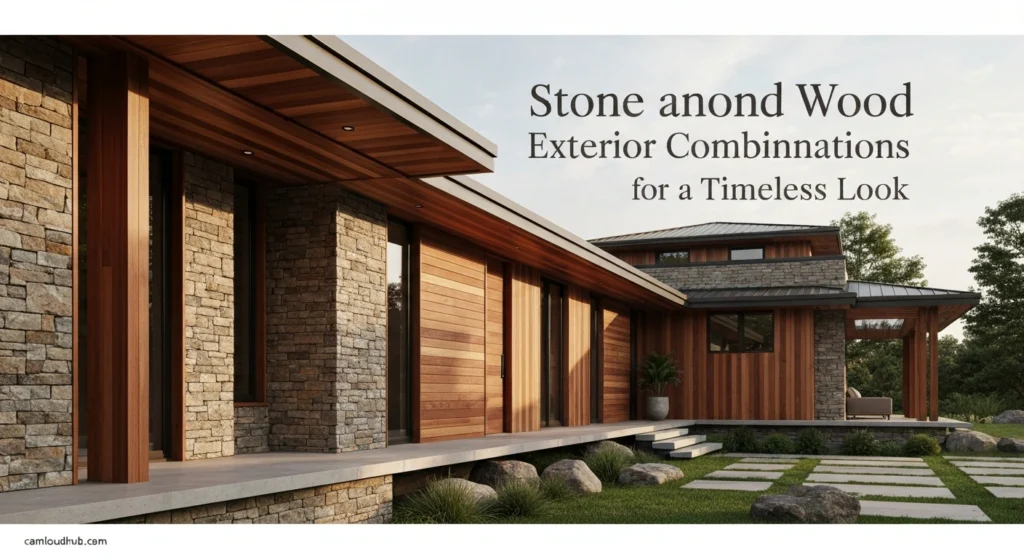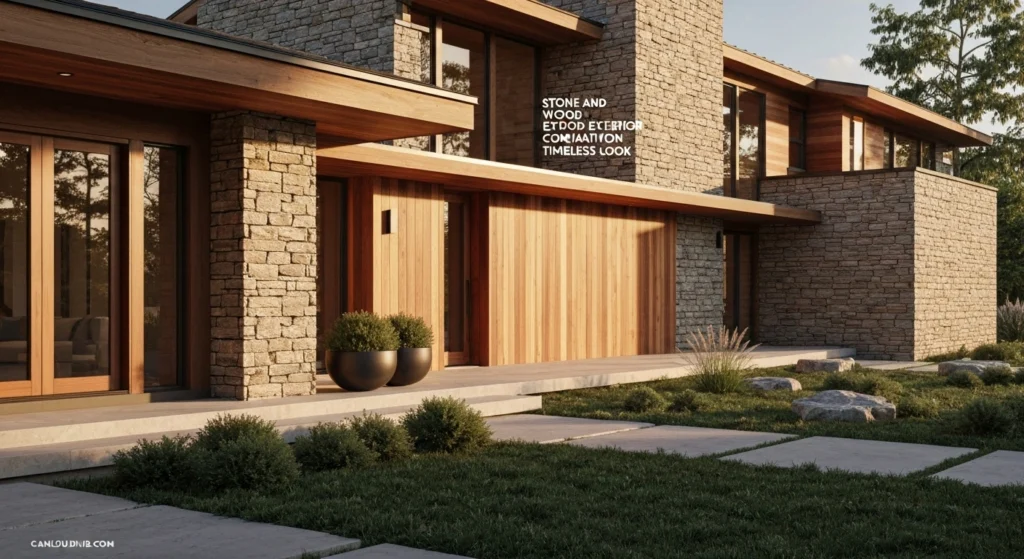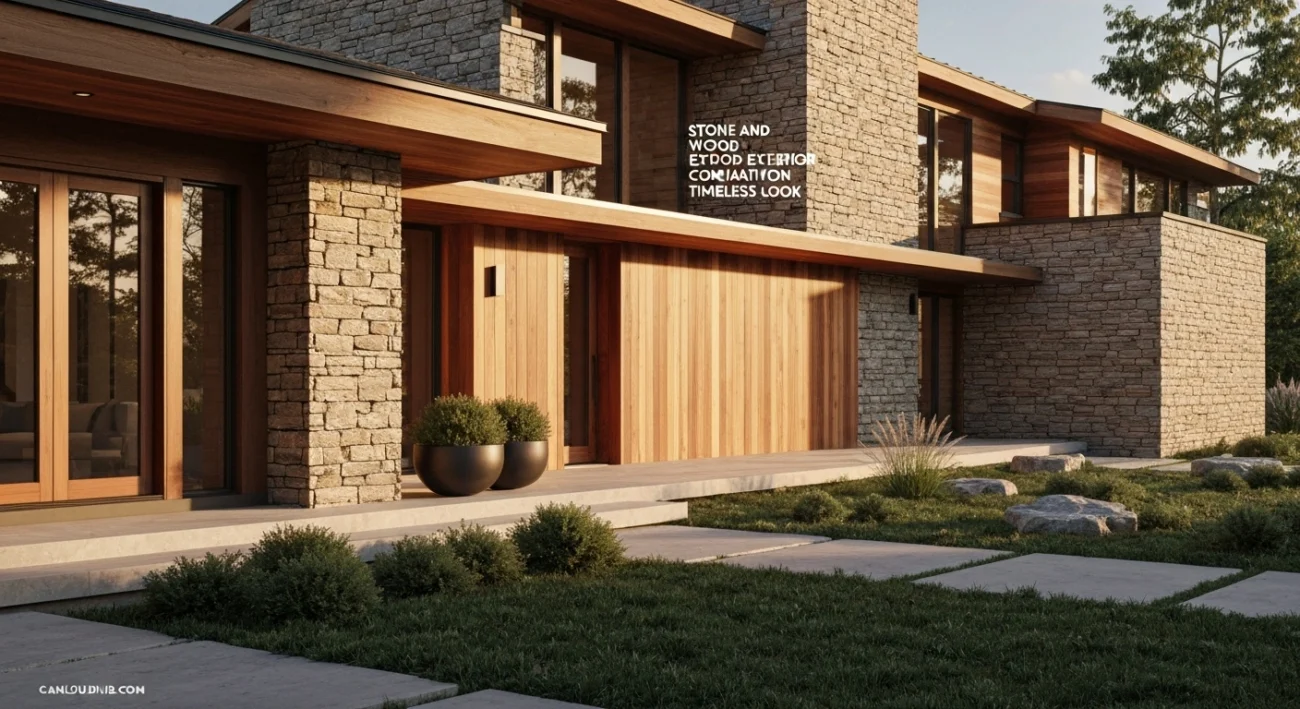Stone and Wood Exterior Combinations for a Timeless Look
Stone and Wood Exterior Combinations for a Timeless Look – The exterior of a home is its first impression, a statement of style and a promise of the life within. For centuries, architects and builders have turned to two fundamental materials to create facades of enduring beauty: stone and wood. These elements, drawn directly from the natural world, possess an intrinsic appeal that transcends fleeting trends and architectural fads.
Combining them is an art form, a delicate balance of texture, color, and proportion that can elevate a structure from a mere building to a timeless piece of architecture. A successful stone and wood exterior design feels both grounded and graceful, strong yet warm. This guide explores the principles, styles, and practical considerations for creating a harmonious and lasting look with these classic materials.

The Enduring Appeal of Natural Materials
There is a primal connection humans have with natural materials like stone and wood. Stone speaks of permanence, of geological time, and of unyielding strength. Its cool, solid presence provides a sense of security and a deep-rooted connection to the earth itself.
Wood, in contrast, offers an organic warmth and a story of life and growth. Its grain tells a unique tale, and its texture invites touch, providing a softness that balances the austerity of stone. The synergy between these two materials lies in this beautiful opposition, creating a visual and tactile richness that synthetic products can rarely replicate. A well-conceived stone and wood exterior design taps into this elemental appeal for a home that feels both authentic and welcoming.
Fundamental Principles of Stone and Wood Exterior Design
Achieving a sophisticated look requires more than simply placing stone and wood on a wall. It involves a thoughtful application of core design principles. These guidelines help ensure the materials complement each other rather than compete for attention. Mastering them is the key to a truly successful stone and wood exterior design.
Achieving Balance and Proportion
Balance is arguably the most critical element in any successful stone and wood exterior design. The visual weight of stone is significant, and it can easily overwhelm a facade if not used judiciously. A common and effective strategy is to use stone as an anchoring element for the home.
Consider applying stone to the foundation, on massive chimneys, or on structural support columns at the base of the home. This grounds the structure, making it appear solid and firmly planted in its landscape. Wood siding or panels can then be used on upper levels, creating a pleasing sense of lightness as the eye moves upward.
Another approach to proportion is the classic 60-30-10 rule, adapted for exterior materials. One material, often the wood siding, might cover 60% of the facade, while stone acts as a major accent covering 30%. The final 10% can be reserved for trim, fascia, or window frames in a contrasting color or material, adding a final layer of polish and definition.
Harmonizing Colors and Tones
The color palette is fundamental to the emotional impact of a home’s exterior. Stone and wood offer a vast spectrum of natural hues, from cool grays and deep charcoals to warm creams, tans, and rich reds. The key to a harmonious combination is understanding the undertones of each material selection.
For a cohesive and tranquil look, select stone and wood with similar undertones. For example, a warm, honey-toned cedar siding pairs beautifully with a tan or cream-colored limestone. This creates a monochromatic feel that is sophisticated and calming. The subtle variations in texture provide more than enough visual interest.
Alternatively, a high-contrast palette can create a dramatic and modern statement. Imagine a dark, almost black, stained wood paired with a bright, white-toned ledgestone. This striking a stone and wood exterior design emphasizes clean lines and architectural form, making it a popular choice for contemporary homes. Always acquire physical samples of your chosen materials to see how they look together in natural daylight before making a final decision.
Creating Texture and Depth
One of the greatest advantages of combining stone and wood is the opportunity to play with texture. The inherent character of each material can be used to add immense visual depth and interest to a facade. The interplay between a rough, rugged surface and a smooth, refined one is a cornerstone of compelling architectural design.
For a rustic and organic feel, pair a rough-hewn fieldstone or a split-face travertine with reclaimed wood siding that features visible saw marks and knots. This combination celebrates the imperfections and raw beauty of the natural materials. The varied shadows created by the uneven surfaces add a dynamic quality that changes throughout the day with the shifting sunlight.
In a more modern context, the textural contrast can be more subtle but equally effective. Consider pairing sleek, honed slate panels with smooth, vertically installed ipe wood siding. The result is a clean, sophisticated look where the texture provides a quiet richness without sacrificing the minimalist aesthetic. A thoughtful stone and wood exterior design will always consider how texture contributes to the overall narrative of the home.

Architectural Styles That Embrace Stone and Wood
While the combination is versatile enough for nearly any style, certain architectural movements have made the pairing of stone and wood a defining characteristic. These styles serve as an excellent source of inspiration. They provide a proven framework for how these materials can be used to create a specific mood and aesthetic. Understanding these applications is vital for anyone planning a stone and wood exterior design.
The Rustic Charm of Mountain and Craftsman Homes
The Mountain Lodge or Mountain Rustic style is perhaps the most iconic example of stone and wood harmony. Born from a need to build with local materials in rugged landscapes, this style emphasizes strength, durability, and a deep connection to nature. Grand, soaring rooflines are supported by massive wood timbers and anchored by substantial stone bases and towering fireplaces.
In this style, materials are often left in a state that is as close to natural as possible. Large, irregular river rocks or fieldstones form the foundation and chimneys, providing a sense of permanence. Heavy, rough-sawn cedar or pine timbers are used for posts, beams, and trusses, showcasing the structural integrity of the home. The stone and wood exterior design of a mountain home is one of robust, handcrafted beauty.
The American Craftsman movement also heavily relies on the honest expression of natural materials. Craftsman homes feature low-pitched gable roofs with wide, overhanging eaves and exposed rafters. A signature element is the tapered porch column, often made of wood and set atop a sturdy pier of stone or brick. This design choice visually anchors the porch to the ground, reinforcing the style’s emphasis on stability and craftsmanship. The combination of wood shingles or lap siding with a stone wainscoting around the base is a classic Craftsman application of stone and wood exterior design.
Modern and Contemporary Interpretations
The pairing of stone and wood is not limited to traditional or rustic architecture. Modern and contemporary designers have enthusiastically embraced these materials, using them to bring warmth and texture to minimalist forms. In modern design, the focus shifts to clean lines, geometric shapes, and a seamless flow between interior and exterior spaces.
Modern homes often feature stone as a dramatic accent wall. This feature might start on the exterior, flow through a large glass window wall, and continue into the living space, blurring the lines between indoors and out. The stone chosen is typically cut into clean, geometric shapes like linear ledgestone or large, smooth panels, emphasizing precision over ruggedness.
This sleek stone is often paired with wood siding applied with a clean, nickel-gap or shiplap profile. The wood brings a necessary warmth to the often-austere geometry of modern architecture. This thoughtful application showcases how a modern stone and wood exterior design can feel both cutting-edge and timelessly connected to nature.
The Mid-Century Modern Approach
Mid-Century Modern (MCM) architecture, which flourished from roughly 1945 to 1969, perfectly illustrates a sophisticated use of natural materials. MCM design celebrated a connection to the outdoors, featuring large expanses of glass, open floor plans, and a blurring of indoor-outdoor living. Stone and wood were essential for achieving this organic-yet-modern aesthetic.
In MCM homes, you will often see a dominant stone feature, such as a prominent chimney stack or a long, low feature wall that defines the entryway. The stone is typically a stacked slate or a linear fieldstone, emphasizing horizontal lines that help integrate the house into its landscape. This strong stone element is balanced by the liberal use of wood.
Wood was used for post-and-beam construction, which was often left exposed, as well as for tongue-and-groove siding and soffits. The ceilings of interior rooms often featured exposed wood decking that continued outside to create covered patios, further uniting the spaces. The stone and wood exterior design in MCM is a masterclass in balancing mass with lightness and integrating a building with its natural surroundings.
The Minimalist and Scandinavian Influence
More recent contemporary design has been heavily influenced by minimalism and Scandinavian principles. These styles prioritize simplicity, functionality, and a light, airy feel. While seemingly stark, they rely heavily on natural materials like stone and wood to create a sense of warmth and hygge (a Danish concept of coziness and contentment).
In this interpretation, the material choices are intentional and refined. A light-colored wood, such as bleached oak, pale birch, or thermally treated pine, is often used as the primary cladding. This wood is applied with precision, often in a vertical orientation to create a sense of height and clean linearity.
Stone is used sparingly but with great impact. It might appear as a simple, elegant base for the structure, a low garden wall, or as sleek paving for the entryway. The stone selected is typically a cool-toned granite or a light gray slate, complementing the pale wood without overwhelming it. This restrained and carefully curated stone and wood exterior design creates a serene, calming, and highly sophisticated aesthetic.
Practical Considerations and Material Selection
Choosing the right materials is a critical step that involves balancing aesthetics, budget, climate, and maintenance tolerance. A beautiful design is only successful if it is also durable and suited to its environment. A deep understanding of material properties is essential for a long-lasting stone and wood exterior design.
There are two main categories of stone application: full-bed stone and stone veneer. Full-bed stone consists of thick, heavy pieces of real stone that are structural and require a concrete ledge for support. Stone veneer, which can be made from either natural thin-cut stone or a manufactured cement-based product, is a lightweight decorative layer applied to the sheathing of the house.
Natural thin stone veneer offers the authentic beauty of real stone at a reduced weight and cost, while manufactured veneer provides a wide range of consistent styles and colors at an even more accessible price point. Wood options are similarly diverse, ranging from classic solid wood siding to modern, high-performance engineered wood products. Each choice comes with its own set of considerations for your stone and wood exterior design.
Selecting the Right Type of Stone
The type of stone you choose will have a profound impact on the overall character of your home. Each variety has a unique color profile, texture, and shape. Understanding these differences is crucial for matching the stone to your desired architectural style.
Limestone is known for its relatively uniform color, typically in shades of cream, tan, or light gray. Its texture is often smooth and consistent, lending it an air of formality and elegance. It is an excellent choice for Traditional, French Country, or even minimalist Modern homes.
Fieldstone refers to naturally occurring, rounded or irregular stones gathered from the surface of fields. Its rustic, varied appearance, with a wide range of colors and shapes, makes it ideal for cottages, farmhouses, and mountain-style homes. It creates a timeless, “old-world” feel.
Ledgestone consists of thin, rectangular strips of stone with a rugged, split face. When stacked, it creates strong horizontal lines and significant texture, making it a very popular choice for modern and contemporary accents. It is often used on feature walls, columns, and chimney stacks. The precise geometry of ledgestone is a key feature in many contemporary stone and wood exterior design projects.
Granite is an igneous rock known for its extreme durability and speckled appearance. Available in a wide range of colors from light gray to dark charcoal and even pinks, it offers a sense of strength and permanence. Its polished or honed surfaces work well in modern designs, while a rougher cut can suit more traditional styles.

Choosing the Best Wood for Your Exterior
The choice of wood siding affects not only the look of your home but also its long-term maintenance requirements. Some woods are naturally more resistant to rot, insects, and moisture than others. Climate is a major factor in this decision.
Western Red Cedar is one of the most popular and prized choices for wood siding. It is naturally lightweight, stable, and contains tannins and oils that make it inherently resistant to decay and insects. It can be stained to a variety of colors or left to weather naturally to a beautiful silvery gray.
Redwood is another premium option, similar to cedar in its natural resistance to rot and pests. It is known for its rich, reddish-brown color and exceptional stability, meaning it is less prone to shrinking or warping. It is a classic choice for Craftsman and Mid-Century Modern homes.
Cypress is a fantastic option for homes in humid or coastal climates due to its high concentration of cypressene, a natural preservative oil. It is extremely water-resistant and durable. Its color ranges from a light yellowish-brown to a reddish-brown.
Thermally modified wood is a modern alternative where wood (often pine or ash) is heated in an oxygen-free environment. This process changes the wood’s cell structure, making it highly resistant to rot and dimensionally stable. It offers the performance of tropical hardwoods in a more sustainable package, making it a forward-thinking choice for any stone and wood exterior design.
Engineered wood siding offers the look of real wood with increased durability and lower maintenance. These products are made from wood fibers, wax, and resins, and are factory-primed and painted. They provide a highly consistent and weather-resistant option for homeowners who desire the wood aesthetic without the upkeep of solid wood.
Conclusion: Crafting a Lasting Legacy
The combination of stone and wood on a home’s exterior is more than just a design choice; it is a commitment to timelessness and authenticity. These natural materials have been used for millennia to create shelter that is not only functional but also deeply beautiful and connected to its environment. By adhering to the fundamental principles of balance, harmony, and texture, you can create a facade that is both striking and serene.
Whether you favor the rustic charm of a mountain lodge, the handcrafted honesty of a Craftsman bungalow, or the clean lines of a modern masterpiece, this classic pairing offers endless possibilities. A thoughtfully executed stone and wood exterior design is an investment in enduring style. It results in a home that not only looks beautiful today but will age gracefully, developing a rich patina and character that will tell its story for generations to come.


